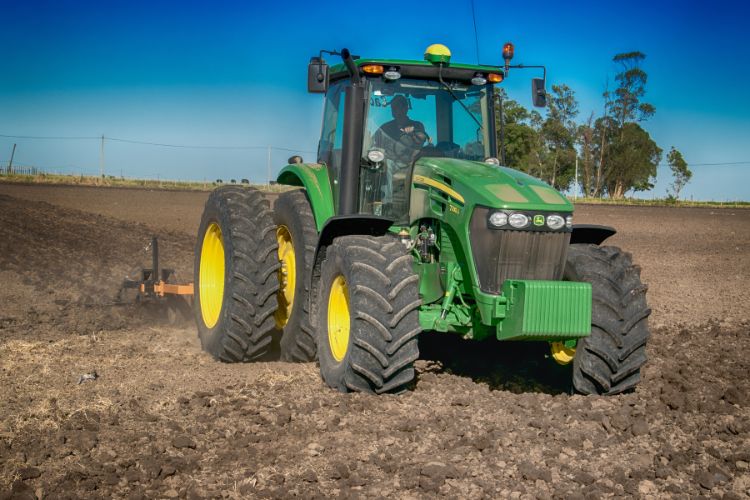Why are John Deere tractors green? The choice goes beyond mere aesthetics. Green represents the heart of agriculture—growth, renewal, and a strong tie to nature. It’s a color farmers connect with as they work the land, season after season. While competitors opted for red or blue, Deere’s green was unique, signaling both brand loyalty and dependability in the fields.
The green and yellow also connect emotionally with farmers. Green is for sprouting crops, while yellow symbolizes harvest. This classic combo made John Deere tractors not just recognizable but meaningful. Through generations, this color choice created an unbreakable bond with the agricultural community.
Keynote: Why Are John Deere Tractors Green?
John Deere tractors are green to symbolize growth and nature, resonating with the farming cycle. This color, paired with yellow, represents planting and harvest, setting Deere apart from competitors. The iconic green-and-yellow scheme, a registered trademark, reinforces Deere’s commitment to quality and tradition in agriculture.
Historical Origins of John Deere’s Green and Yellow
In the early 1900s, colors became a defining feature in agricultural equipment, helping brands stand out. Many manufacturers, such as International Harvester and Ford, chose red and blue to make their machinery easy to spot in open fields. Red, especially, became associated with farm equipment as companies used it to make a bold statement, highlighting durability and reliability.
For John Deere, however, green was chosen to convey a deeper connection to growth and the agricultural cycle, setting the brand apart in both identity and message.
John Deere’s acquisition of the Waterloo Engine Company in 1918 marked a significant turning point in its branding. The Waterloo Boy, a tractor already painted green, likely influenced Deere’s decision to adopt the color.
Rather than rebrand entirely, Deere embraced green, using it to symbolize new growth, while yellow represented the ripening of crops. This choice helped Deere create a unique brand identity that farmers could easily identify and trust in a competitive market.
| Era | Key Milestone | Color Decisions |
|---|---|---|
| 1910s | Acquisition of Waterloo Engine Company | Continued use of green for tractors |
| 1930s-1950s | Standardization of Green and Yellow Scheme | Distinct green for growth, yellow for harvest readiness |
| 1980s | Official Trademark of John Deere Green | Protection of the unique color scheme |
| 2017 | Trademark Lawsuit Success | Legal protection for exclusive green and yellow use |
Symbolic Meaning Behind the Colors

The choice of green and yellow for John Deere equipment is more than aesthetic; it’s deeply symbolic.
Green, representing fresh growth, connects to the early stages of planting when the land springs to life.
Yellow, on the other hand, mirrors the rich colors of harvest-ready crops, signaling the rewards of hard work.
Farmers often resonate with this symbolism, noting that the green reflects the potential they nurture in their fields, while yellow captures the fruition of their labor. As one farmer put it, “When I see that green, I think of the promise of a new season. The yellow? That’s the reward.”
For many farmers, John Deere’s color scheme mirrors the cycles of farming itself. Green fields mean the beginning of growth, the early stages that require patience and hope. When harvest season arrives, the warm yellow hue symbolizes fulfillment.
This emotional connection has created a lasting bond, with farmers viewing Deere’s green and yellow as an emblem of the life cycles they are part of. “It’s a cycle we see every year,” a farmer shared. “Green is our beginning, and yellow is our goal.” These colors, tied so closely to nature and the rhythms of agriculture, have allowed John Deere to become not just a brand, but a symbol of the farming lifestyle.
Green as a Competitive Differentiator
In a market crowded with shades of red, John Deere made a strategic move by adopting green as its primary color. Major competitors like Case IH and International Harvester had already claimed red, giving Deere a perfect opportunity to stand apart visually.
The choice wasn’t merely aesthetic; it became symbolic, reflecting nature and aligning the brand with growth, a core element in farming. Farmers could quickly recognize a Deere tractor in a sea of red machinery, giving Deere an identity boost and fostering loyalty among its customers.
The “color wars” among tractor brands began in the early 20th century as manufacturers sought ways to capture attention in the field. Red became the standard for many brands, partly due to its high visibility. However, Deere’s choice of green created an instant visual divide, sparking a friendly rivalry that remains to this day.
Green became Deere’s banner, setting it apart from competitors and solidifying its brand presence. This color choice wasn’t just a preference—it became Deere’s mark, recognized instantly and synonymous with quality and dependability in agriculture.
Farmers, in turn, embraced this identity, creating a long-standing loyalty that continues to support John Deere’s position as an industry leader.
Marketing and Legal Protection of John Deere Green
In 2017, John Deere took legal action to secure its exclusive rights to the green and yellow color scheme, asserting its deep association with quality and durability in agricultural equipment. By suing competitors who used similar shades, Deere aimed to protect its brand identity and the trust farmers placed in those colors.
The court upheld Deere’s claim, ruling that the green and yellow combination was strongly tied to Deere’s reputation, making it a “famous” trademark. This legal victory highlighted the company’s commitment to maintaining its distinct identity in a crowded marketplace.
With this legal recognition, John Deere’s colors transcended branding, becoming iconic symbols within farming communities. The trademark protection reinforced Deere’s image as a brand of unmatched reliability, ensuring that when farmers saw green and yellow, they could trust the quality of the machine.
This association strengthened loyalty among farmers who felt the colors symbolized their own values of resilience and growth. John Deere’s green and yellow didn’t just signify machinery—they represented a lifestyle, deeply resonating with the farming community and solidifying the brand’s legendary status in agriculture.
Cultural and Global Recognition of John Deere Colors
John Deere’s iconic green and yellow color scheme has become instantly recognizable worldwide, transcending borders and agricultural communities. From North America to Europe, Asia, and beyond, Deere’s colors signal quality, reliability, and an agricultural legacy.
Farmers around the world associate the green with the promise of growth and resilience, while yellow signifies harvest and prosperity. This global appeal has turned Deere’s green and yellow into more than just colors—they are symbols that resonate with rural and farming communities everywhere, where they have come to represent both innovation and tradition.
While green and yellow define John Deere’s agricultural line, the brand uses different colors for distinct product categories. In its construction line, Deere adopted a primary yellow with black trim to differentiate these machines from its agricultural equipment while still retaining brand recognition.
This adaptation of color not only meets practical needs for construction visibility but also reinforces Deere’s attention to safety and industry-specific requirements. By maintaining these variations, Deere ensures that each product line remains distinct while upholding its strong visual identity across sectors, a testament to the brand’s thoughtful approach to color and recognition.
Final Thoughts
In choosing green, John Deere did more than make its tractors visually distinctive; it created a color legacy that speaks to the heart of agriculture. This choice embodies more than branding; it’s about capturing the spirit of growth, resilience, and the farming journey itself. Green represents the cycle of life in fields worldwide, a connection that keeps Deere’s green and yellow instantly recognizable and beloved.
As you see a John Deere tractor working the land, remember: it’s not just machinery; it’s a piece of history and culture that transcends generations. Those colors are symbols of trust, connecting past and future, soil and harvest, person and machine.
Read more: John Deere vs Kubota Compact Tractors: Which One to Choose?
Green John Deere Tractors (FAQs)
Why does John Deere use the color green?
John Deere uses green to symbolize growth and its commitment to the farming lifecycle. Green represents new crops, while the yellow accent reflects harvest, reinforcing their connection to agriculture. The color also differentiates Deere from competitors and enhances brand identity in farming communities.
Are all green tractors John Deere?
Not all green tractors are John Deere. Some other manufacturers, including Fendt and older Oliver models, also produce green tractors. However, John Deere’s unique green with yellow trim is trademarked, making it instantly recognizable worldwide.
Why are most tractors green?
Most tractors aren’t necessarily green, but green has agricultural symbolism tied to growth and nature. John Deere popularized green in the agricultural sector, leading some farmers to associate green machinery with quality and reliability.
What color was the original John Deere tractor?
The original John Deere tractor was green with yellow wheels, a tradition that began with the Waterloo Boy tractor in the early 1900s. This color scheme has since become a hallmark of Deere’s brand identity.
Why is Some John Deere Equipment Yellow?
John Deere’s construction equipment is painted yellow to distinguish it from its agricultural line. Yellow enhances visibility on job sites, aligning with industry standards and safety needs in construction environments.
Why are American tractors nearly always Green?
American tractors aren’t exclusively green, though John Deere’s green is widely recognized in agriculture. Tractors from Case IH and other brands commonly use red, but John Deere’s green stands out, symbolizing growth and reliability for many farmers.
Why is John Deere’s classic green color so iconic?
John Deere’s classic green, with its yellow wheel combination, is iconic in agriculture, symbolizing growth and tradition. This color combination has been a registered trademark of the John Deere Corporation, making it distinct in farming communities worldwide.
Did other brands like Massey Ferguson or Allis-Chalmers use green paint?
Massey Ferguson, Allis-Chalmers, and New Holland use different color schemes—mostly red and orange—to differentiate from Deere’s green. AGCO Corporation, which owns brands like AGCO Allis, holds registered trademarks for these color schemes, emphasizing each brand’s identity.
Was the original John Deere equipment green?
Yes, John Deere’s earliest equipment, including the Mansur corn planter, used a green frame, with the company later adopting green as its primary color. This green frame on early implements became part of Deere’s visual identity, further solidified under the company’s new name, Deere & Company.
Who owns the tradenames and colors for brands like JD and AGCO?
The John Deere Corporation and AGCO Corporation hold registered trademarks for their respective color combinations and tradenames. None of these trademark holders share their specific brand colors or trademarks with others, ensuring each remains unique in the market.

Chris has 15 years of experience using all the latest technologies, machinery, and equipment available on the market today. His diverse experience allows him to provide homeowners with the best possible results while saving them a lot of time and money. When it comes to Lawn Tractors, Chris knows every model there is – so if you’re looking for advice, he’s your man!